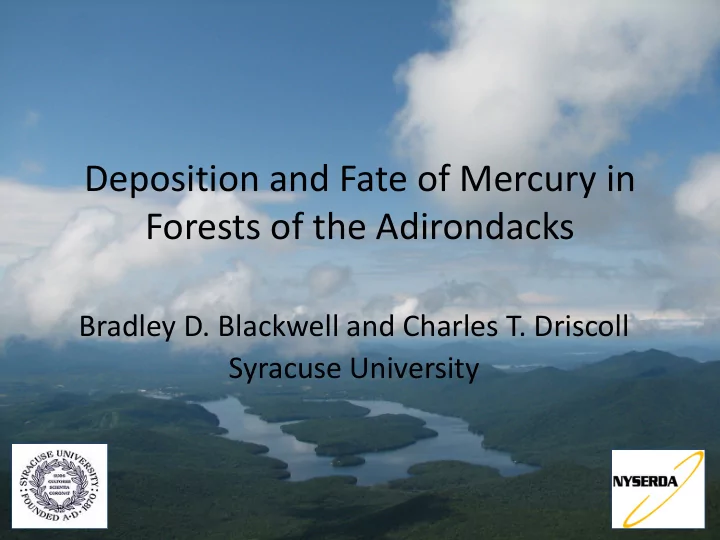

Deposition and Fate of Mercury in Forests of the Adirondacks Bradley D. Blackwell and Charles T. Driscoll Syracuse University
Mercury Cycle
Deposition • Wet deposition occurs through precipitation • Throughfall enrichment • Dry deposition includes particulates and gaseous Hg • Uptake by foliage • Variable across landscape Vijayaraghavan et al. 2007
Adirondack Park • Largest park in the continental U.S. • Important conservation and recreation area • Receives mercury deposition from local, regional, and global sources • Biological mercury “hotspot” • Park-wide fish mercury advisory plus 55 individual water body advisories
Mercury Deposition in Adirondack Park • Historical yearly deposition 5 µg/m 2 ; current estimates 9 µg/m 2 (Lorey and Driscoll 1999) • Regional Sources – Ohio Valley, Pennsylvania, Texas • Global Sources – Up to 20% from Asia (Seigneur et al. 2003) Choi et al. 2008
Research Overview Phase 1: Compare mercury • cycling dynamics in hardwood and conifer forests (Huntington Forest) • Phase 2: Examine mercury deposition along an elevation gradient (Whiteface Mountain) Phase 3: Conduct spatial analysis • of mercury in foliage and soil across Adirondack Park (50 sites)
Wet Deposition – Huntington Forest 25 MDN Hardwood Conifer 20 15 Hg (ng/L) 10 5 0
Wet Deposition – Whiteface Mountain 10 Hardwood Spruce/Fir Alpine 8 Cloudwater 6 Hg (ng/L) 4 2 0
Wet Deposition – Whiteface Mountain 35 30 25 Hardwood 20 Spruce/Fir Hg (ng/L) 15 Alpine 10 5 0 0 5 10 15 20 25 DOC (ppm)
Foliar Mercury - 2010 40 35 Yellow Birch Sugar Maple 35 30 30 25 25 Hg (ng/g) Hg (ng/g) 20 20 15 15 10 10 5 5 R 2 = 0.9285 R 2 = 0.9411 0 0 0 50 100 150 0 50 100 150 Days Days 30 American Beech White Pine 25 30 20 Hg (ng/g) 25 15 Hg (ng/g) 20 Age 1 15 10 Age 2 10 5 5 R 2 = 0.9604 0 0 0 50 100 150 0 50 100 150 Days Days
Spatial Survey - Latitude South North
Spatial Survey - Longitude West East
Spatial Survey - Elevation
Foliar Mercury Elevation Patterns (Paper Birch) 35 2009 (R 2 =0.4358) 2010 (R 2 =0.0168) 30 25 Hg (ng/ g) 20 15 10 5 400 600 800 1000 1200 1400 1600 Elevation (m)
Deposition Totals – Whiteface Mountain 40 Throughfall Lit t er Hg Deposition (ug/ m2/ year) 30 Cloudwat er 20 10 0 Hardwood S pruce/ Fir Alpine
Foliar – Soil Mercury 450 400 350 300 250 Hg (ng/g dw) 200 150 30 20 Foliage 10 Oi/Oe Oa 0 Beech Maple Pine Spruce Fir Dominant Species
Soil Profiles – Huntington Forest 8 Oa 7 6 Bh 5 Bs1 4 Bs2 3 Bs3 2 Conifer C 1 Hardwood 0 0 50 100 150 Hg (ng/g)
Soil Patterns Organic Soil Mercury 900 800 700 Hg (ng/g) 600 500 400 300 200 100 R² = 0.4457 0 400 600 800 1000 1200 1400 1600 Elevation
Spatial Survey - Elevation
Conclusions • Deposition pathways contribute mercury differently among different forest types • Mercury accumulates and concentrates in organic soil layers • Latitude, longitude, and elevation all have significant effects on foliar and soil mercury concentrations in Adirondack Park
Future Plans • Publish data presented • Develop model and map of atmospheric deposition in Adirondack Park • Create GIS layer of mercury deposition that will be available to researchers and managers
Acknowledgements • Clarkson University • DEC • Eric Hebert • West Virginia University, Wisconsin
Recommend
More recommend